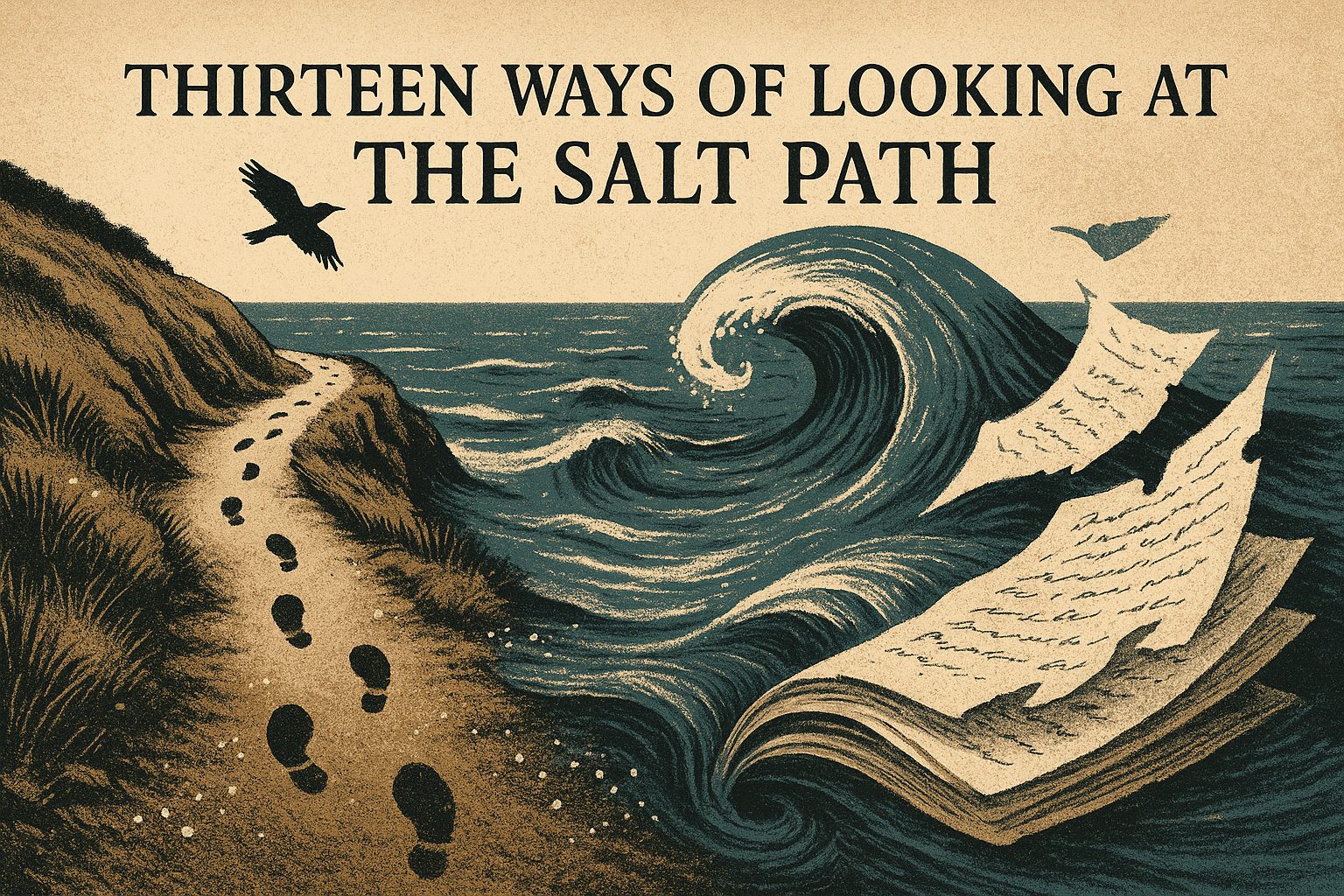
Like many readers, I was profoundly moved by The Salt Path. I read it, listened to it, taught from it, and revisited the South West Coast Path with my son in its wake. I reviewed the film with admiration in my article Five Salty Lessons from The Salt Path: Walking the Edge of the World, exploring its themes of grief, healing, love, place and presence.
But now, in the wake of The Observer’s detailed investigation, I find myself hollowed out.
If the reporting is accurate, the story told by Raynor Winn, whose real name is Sally Walker, and her husband Moth (Tim Walker) is not only artful but also deeply misleading. It appears to misrepresent key facts about their history, finances and legal difficulties, while failing to acknowledge debts, allegations of embezzlement, and ownership of a second property. For those of us who were emotionally and professionally invested in their narrative, the revelations are profoundly disappointing. At worst, they feel like a betrayal.
And yet, the book is still with us. So are the landscape, the coastline, the pain, the love. Rather than cancel or excuse The Salt Path, I want to turn it carefully, holding it up to the light. These are thirteen ways of looking at it now.
1. Memoir is never complete truth, but it must not deceive
We accept that memoirs involve subjectivity, selective memory, and personal emphasis. But there is a boundary between omission and invention. If, as The Observer reports, significant aspects of the Walkers’ backstory were concealed or misrepresented, including the nature of the court case that led to their eviction, this crosses a critical ethical line.
2. We believed in them because they seemed honest
Readers supported Sally and Tim Walker because they appeared to be decent, generous people brought low by misfortune. We empathised not just with their hardship but with the moral nobility of their suffering. If this moral frame is false, the entire reading experience is altered.
3. The story inspired others to act
Walkers took to the path. Teachers built lessons around the text. People with illness or hardship found courage in their journey. The story had real-world consequences. That impact cannot be dismissed lightly.
4. The coastline remains unchanged
The wind, the rain, the cliffs, the sting of salt on skin: these are real. The South West Coast Path exists regardless of who walks it or how their story is told. The physical and spiritual challenge of walking remains meaningful even if the narrative is tainted.
5. Others were harmed and remain unheard
The Observer’s reporting gives voice to Ros Hemmings and her late husband Martin, who claim they were victims of theft at the hands of Sally Walker. The £64,000 allegedly embezzled from their family business, and the subsequent non-disclosure agreement that prevented them from speaking out, cast a long shadow over the book’s opening chapters. The people whose pain preceded the memoir have rarely been acknowledged.
6. The portrayal of Moth’s illness now appears questionable
Central to The Salt Path is the diagnosis of Tim Walker with corticobasal degeneration. Multiple neurologists interviewed in the article express scepticism about the progression and apparent reversal of his condition, suggesting the diagnosis may have been incorrect or misrepresented. If so, this not only undermines the story but also risks spreading false hope to those living with serious neurodegenerative diseases.
7. The narrative fits a marketable myth
Sally and Tim Walker, under the names Raynor and Moth Winn, were the perfect protagonists for a certain kind of publishing story. Educated, white, articulate, middle-aged and apparently penniless, they embodied the resilient, poetic poor. But this narrative glosses over the reality of structural homelessness and can obscure more uncomfortable truths about who becomes visible and who does not.
8. Literary beauty does not equal moral authority
The lyrical writing, the evocative descriptions, the carefully crafted metaphors: all of these seduced readers. But beautiful prose does not confer integrity. Memoirists must be held to the same ethical standards as journalists when claiming to tell the truth.
9. Forgiveness and accountability must coexist
Readers can still find moments of truth, beauty or solace in the book. That does not preclude the need for the authors and their publishers to be held accountable for what now appears to be a serious misrepresentation of fact.
10. We wanted the story to be true
Part of the sting lies in how deeply people wanted to believe. The story gave hope. It offered redemption. It allowed readers to imagine that love and walking and salt could heal all wounds. This desire made the deception all the more effective—and painful.
11. The publishing industry must respond
Penguin continues to describe The Salt Path as “unflinchingly honest.” If this claim no longer stands up to scrutiny, the publisher must act transparently—either by offering clarification or issuing a public response. Silence, in this case, is not neutral.
12. Teaching the book now requires ethical framing
As educators, we must now teach The Salt Path differently. It cannot be presented as an unfiltered account of resilience and transformation. If it is taught, it must be within a frame that includes ethical discussion, narrative construction and the politics of memoir.
13. The path remains—but so does the question of trust
I will not un-walk the path I trod with my son, nor un-feel the emotional resonance the book once offered. But I will not walk it again without thinking of those left behind in the story: the unpaid debts, the rebranded identities, the silence around wrongdoing. The salt in the story now stings differently.
This is not about moral perfection. All memoirs are partial. But when a memoir sells itself as a tale of unvarnished truth and then appears to mislead readers on a foundational level, the damage is real. The trust that underpins the genre begins to erode. As I wrote in my original piece, Five Salty Lessons, the path is not a metaphor. It is a real place. It deserves real stories.
Let us keep walking, but with clearer eyes and more demanding questions.
The title of this piece borrows from Wallace Stevens’ Thirteen Ways of Looking at a Blackbird, a poem that, like this situation, resists simple meaning. Stevens reminds us that “the world imagined is the ultimate good,” but also that we “do not know which to prefer”—the clear singing of a truth or the beauty of its shadow.
I end with a quiet call: to hold space for complexity, to demand truth in publishing, and to remember that how a story is told matters as much as what it claims to say.
Let us honour the salt—by which I mean the sting of disappointment, the cleansing of critical thought, and the preserving power of ethical storytelling.
Further Reading:
• The Observer investigation: “The Real Salt Path: How the couple behind a bestseller left a trail of debt and deceit”
• My earlier review: Five Salty Lessons from The Salt Path
© Francis Gilbert, 2025
Author of The Mindful Creative Writing Teacher
Head of MA Creative Writing and Education, Goldsmiths


Leave a Reply